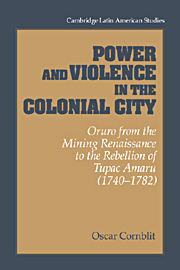 Power and Violence in the Colonial City
Power and Violence in the Colonial City Book contents
- Frontmatter
- Contents
- List of figure, maps, and tables
- Preface
- Map 1 Present-day Bolivia and surrounds
- Map 2 Principal routes of the Viceroyalty of Peru (second half of the eighteenth century)
- 1 Oruro between two epochs: a mining cycle
- 2 Under Spanish law
- 3 Oruro in 1741: details of a stormy election
- 4 The people
- 5 “Madmen, comedians, and hypocrites”
- 6 Captains of shipwreck
- 7 Returning to the known
- 8 “The fruits of the earth”
- 9 The end of an epoch: the Indian uprisings of 1780–1781
- 10 Oruro in the economic and geopolitical context of the epoch (c. 1780–1781)
- 11 The Oruro uprising
- 12 The voice of the rebels
- 13 Picking up the pieces
- Appendix A Indian raids on Oruro, 1781: testimonies
- Appendix B Testimonies of inhabitants of the city
- Appendix C Table of public jobs in Oruro, 1730–1784
- Bibliography
- Index
- CAMBRIDGE LATIN AMERICAN STUDIES
5 - “Madmen, comedians, and hypocrites”
Published online by Cambridge University Press: 30 March 2010
- Frontmatter
- Contents
- List of figure, maps, and tables
- Preface
- Map 1 Present-day Bolivia and surrounds
- Map 2 Principal routes of the Viceroyalty of Peru (second half of the eighteenth century)
- 1 Oruro between two epochs: a mining cycle
- 2 Under Spanish law
- 3 Oruro in 1741: details of a stormy election
- 4 The people
- 5 “Madmen, comedians, and hypocrites”
- 6 Captains of shipwreck
- 7 Returning to the known
- 8 “The fruits of the earth”
- 9 The end of an epoch: the Indian uprisings of 1780–1781
- 10 Oruro in the economic and geopolitical context of the epoch (c. 1780–1781)
- 11 The Oruro uprising
- 12 The voice of the rebels
- 13 Picking up the pieces
- Appendix A Indian raids on Oruro, 1781: testimonies
- Appendix B Testimonies of inhabitants of the city
- Appendix C Table of public jobs in Oruro, 1730–1784
- Bibliography
- Index
- CAMBRIDGE LATIN AMERICAN STUDIES
Summary
The years following the agitated elections of 1741 passed, apparently, without significant trouble. Judging by what followed, however, it appears that the animosity between the opposing factions continued unabated. In the period 1745–7 things reached another boiling point.
In 1745 there was a change of viceroy: the Marqués de Villa Garcia (1735–45) was succeeded by José Antonio Manso de Velazco, count of Superunda (1745–61). At least concerning Oruro, the new administration showed itself to be more energetic and disposed to put a definitive end to internal discord.
By the middle of 1745 the familiar symptoms had already begun to make their appearance again. Letters to the viceroy from one side or the other, containing various ploys and manipulations, indicate that the recurrent theme of every year's end was beginning to gleam on the horizon: the question of who controlled the votes for the alcaldías.
By October 1745, the Herrerist acolytes began their campaign, sending the viceroy a paper on the topic. In it, they recalled with nostalgia the good old times when the corregimiento was in the hands of Martín de Espeleta, and they revived an interesting point of view:
Since the time when Don Martín de Espeleta was corregidor of the town, on account of the punishment he gave to Juan Velez de Cordoba and his supporters, because of the plot whereby they tried to revolt against these provinces to the detriment of these kingdoms, there have been several enemy disputes that continue in this area with no small disruption.
- Type
- Chapter
- Information
- Power and Violence in the Colonial CityOruro from the Mining Renaissance to the Rebellion of Tupac Amaru (1740–1782), pp. 63 - 71Publisher: Cambridge University PressPrint publication year: 1995


